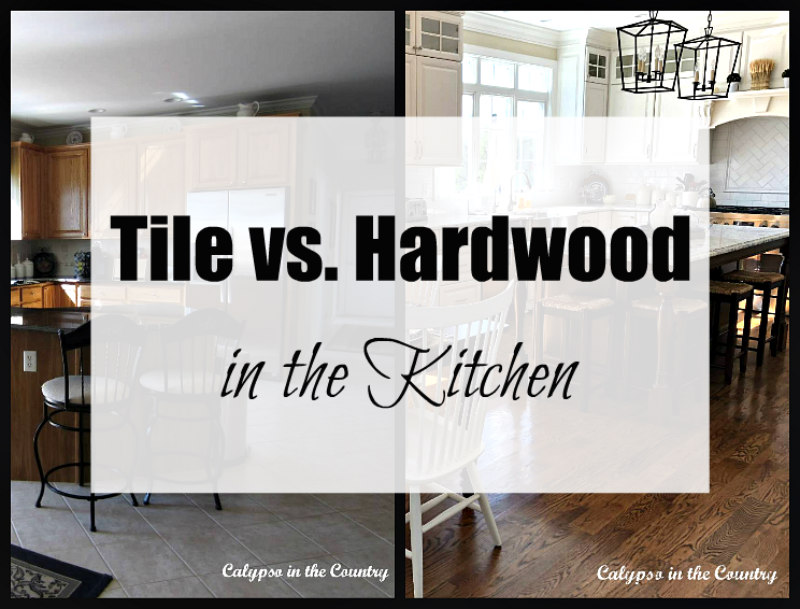Choosing the right flooring for your kitchen can feel like a daunting task. You’re standing at the crossroads, wondering whether tile or wood is the best fit for your home.
Both options offer unique benefits, but what truly aligns with your lifestyle and design preferences? Imagine walking into your kitchen each morning, the floor beneath your feet reflecting your personal taste and enhancing the overall ambiance. This decision isn’t just about aesthetics; it’s about functionality and creating a space where memories are made.
Dive into this article to discover the pros and cons of tile and wood kitchen flooring. By the end, you’ll have the insights needed to make an informed choice that satisfies both your practical needs and your style aspirations.

Credit: www.calypsointhecountry.com
Choosing The Right Flooring
Choosing the right flooring for your kitchen is crucial. It affects functionality and style. Two popular options are tile and wood. Each has its benefits and drawbacks. Understanding your needs helps in making the right choice. Let’s explore key factors to consider.
Factors To Consider
Durability is a primary concern. Kitchens face heavy foot traffic. Tile flooring is known for its toughness. It resists scratches and moisture. Wood offers a warm look but needs more care.
Consider maintenance needs. Tiles are easy to clean. Spills wipe up without staining. Wood needs regular sealing. It can warp if exposed to water.
Cost is another factor. Tile installation can be expensive. Yet, it may save money long-term due to its longevity. Wood can be costlier to maintain over time.
Impact On Kitchen Aesthetics
The flooring choice affects kitchen aesthetics. Tiles come in various designs. They can mimic natural stone or other textures. This offers flexibility in creating a unique look.
Wood flooring gives a warm, inviting feel. It works well with traditional and modern styles. The natural grain adds character and depth.
Color options also play a role. Tiles offer vast color ranges. They can brighten or soften a space. Wood tones can add warmth and richness.
Both materials can define the kitchen’s vibe. Choose based on your style preference.
Tile Flooring Advantages
Tile flooring offers many advantages for kitchen spaces. It combines durability, style, and ease of maintenance. Homeowners often prefer tiles for their versatility. They can withstand heavy use and still look great.
Durability And Maintenance
Tile flooring is tough. It resists scratches and stains. This makes it ideal for busy kitchens. Cleaning tiles is simple. Regular sweeping and mopping keep them pristine. Tiles do not absorb spills, reducing risk of damage. They last for years with minimal upkeep.
Variety Of Styles And Designs
Tiles come in countless styles. From classic to modern, options abound. Choose colors and patterns that match your kitchen’s theme. Tiles mimic natural stone, wood, or even concrete. This flexibility allows personal expression. Tailor your kitchen’s look with ease.
Wood Flooring Benefits
Choosing the right flooring for your kitchen impacts style and function. Wood flooring offers numerous benefits that make it a popular choice. It adds warmth and elegance to any kitchen space. Let’s explore the benefits of wood flooring.
Warmth And Elegance
Wood flooring brings a natural warmth to your kitchen. It creates a cozy and inviting atmosphere. The rich tones of wood add elegance to any design. Wood floors age gracefully, enhancing their beauty over time.
The warmth of wood flooring is unmatched. It makes the kitchen feel more like home. Wood’s natural texture adds depth and character. This elevates the overall look of your kitchen.
Versatility In Design
Wood flooring offers numerous design possibilities. It complements both modern and traditional styles. You can choose from various wood species. Each offers its unique color and grain patterns.
Staining wood floors allows you to match your kitchen decor. You can also refinish them to change the look. This makes wood flooring a flexible choice. It adapts to changing design trends and personal tastes.

Credit: www.deancabinetry.com
Comparing Costs
Choosing between tile and wood kitchen flooring often boils down to cost. Both options have unique price points and value propositions. Understanding the financial implications helps in making a well-informed decision.
Initial Investment
Tile flooring usually demands a higher initial investment. Quality tiles range from mid to high prices. Installation costs add significantly due to labor and materials. Wood flooring offers a range of prices. Less expensive options exist, like laminate or engineered wood. Installation for wood is often less costly than tile. This makes wood a more accessible choice for budget-conscious homeowners.
Long-term Value
Tile flooring is known for its durability. It often lasts decades without needing replacement. This longevity means a better return on initial investment. Maintenance costs remain low, enhancing its long-term value.
Wood flooring provides warmth and natural aesthetics. It can increase the resale value of a home. Regular maintenance ensures wood stays beautiful and functional. Costs may arise from refinishing or repairs over time. Despite these costs, many find wood flooring’s charm worth the investment.
Installation Considerations
Choosing between tile and wood for kitchen flooring involves different installation needs. Tile requires careful alignment and grouting, offering water resistance. Wood flooring needs precise cutting and sealing, providing warmth but requiring moisture protection. Consider your kitchen’s humidity and style preference to make the best choice.
Choosing between tile and wood kitchen flooring can be a daunting decision, especially when you consider the installation process. The ease of installation, whether you decide to go the DIY route or hire a professional, significantly impacts your budget and timeline. As you weigh your options, it’s crucial to understand the installation considerations that come with each material.Ease Of Installation
Tile flooring usually requires more prep work. You’ll need a level subfloor and possibly an underlayment to ensure durability. Cutting tiles to fit the space and grouting can be challenging, especially in small or irregularly shaped kitchens. Wood flooring is generally easier to install, particularly if you opt for engineered wood or click-lock systems. These options often come pre-finished, saving you time and effort. Imagine the satisfaction of snapping pieces into place and seeing your new floor come together seamlessly. Consider your skill level and available tools. Have you installed flooring before? If not, wood might be the less daunting option for a DIY project.Professional Vs Diy
Hiring a professional for tile installation might be worth the investment. They bring specialized tools and expertise to handle complex layouts and ensure a perfect finish. This is especially important in kitchens, where precision can prevent future problems like cracked tiles or uneven surfaces. On the other hand, DIY wood flooring can be a rewarding weekend project. Many homeowners find they can install engineered wood or laminate on their own with basic tools. Watching tutorials and reading guides can boost your confidence. Think about your time and patience. Are you willing to spend your weekends tackling this project, or would you rather leave it to the pros? Balancing your budget with your willingness to learn new skills could tip the scale in your decision. Ultimately, your choice between tile and wood flooring should align with your personal preferences and practical needs. Consider your lifestyle, budget, and the specific demands of your kitchen. Have you weighed all the pros and cons for your unique situation?
Credit: www.ranneyblair.com
Environmental Impact
Choosing the right kitchen flooring isn’t just about aesthetics or durability; it’s also about considering the environmental impact. As you weigh tile against wood, you might find yourself asking: which option is kinder to the planet? The answer isn’t always straightforward. Let’s dive into the sustainability of these materials and explore eco-friendly choices that align with your values and lifestyle.
Sustainability Of Materials
Wood flooring is often praised for its natural beauty, but its sustainability can vary significantly. If sourced responsibly, wood can be a renewable resource. Look for certifications like FSC (Forest Stewardship Council) that ensure the wood comes from responsibly managed forests.
However, the production and transportation of wood can contribute to deforestation and carbon emissions. Consider reclaimed wood as an alternative. Reclaimed wood not only reduces waste but gives your kitchen a unique character.
Tile, on the other hand, is made from natural materials like clay and sand, which are abundant. The production process of tiles is energy-intensive, but advancements in manufacturing are reducing this impact. Some tile companies are adopting more sustainable practices, such as recycling water and using renewable energy.
Eco-friendly Choices
Are you wondering how to make eco-friendly choices for your kitchen flooring? Start by researching brands that prioritize sustainability. Many flooring companies offer eco-friendly options, such as tiles made from recycled materials or wood sourced from managed forests.
Consider the lifecycle of the material. Wood may be biodegradable, but if it’s chemically treated, it could harm the environment during disposal. Tiles, though less biodegradable, often have a longer lifespan, reducing the need for replacement.
Think about the maintenance of your flooring choice. Wood may require chemical treatments for longevity, whereas tile is relatively low-maintenance and can be cleaned with simple, non-toxic solutions. Which option aligns with your lifestyle and commitment to the environment?
Choosing between tile and wood for your kitchen isn’t just a personal preference; it’s a decision that impacts the planet. With these insights, you can make a choice that not only enhances your kitchen’s look but also contributes positively to the environment. So, what will your choice be?
Trends In Kitchen Flooring
Kitchen flooring trends evolve with changing tastes and technology. Homeowners today seek durable and stylish options. Tile and wood remain top contenders. Each offers unique benefits and aesthetics. Choosing between them depends on personal style and practical needs. Let’s explore the current styles and future predictions in kitchen flooring.
Current Popular Styles
Wood floors bring warmth and elegance to kitchens. Light oak and walnut shades are trending. They offer a timeless look that complements various designs. Engineered wood provides extra durability. It resists moisture better than solid wood.
Tiles, especially porcelain and ceramic, are popular for their versatility. They come in endless patterns and colors. Hexagon and herringbone patterns are in vogue. These styles add visual interest and depth. Large-format tiles create a seamless and spacious look.
Future Predictions
Eco-friendly materials will dominate future flooring choices. Bamboo and reclaimed wood are sustainable options gaining popularity. They provide a unique look and reduce environmental impact.
Technological advancements will enhance tile features. Expect more slip-resistant and self-cleaning options. These innovations offer convenience and safety. Bold colors and geometric patterns will continue to rise. They bring character and modern flair to kitchen spaces.
Frequently Asked Questions
What Are The Benefits Of Tile Kitchen Flooring?
Tile is durable and water-resistant. It comes in many styles and colors. Easy to clean.
Is Wood Flooring Suitable For Kitchens?
Yes, but it requires care. Wood adds warmth and charm. Needs protection from moisture.
Which Is More Cost-effective, Tile Or Wood?
Tile is often cheaper upfront. Wood may cost more in the beginning. Consider maintenance costs.
How Does Tile Compare To Wood In Durability?
Tile is generally more durable. Wood can scratch and dent. Tile withstands heavy use.
Can Tile Or Wood Flooring Increase Home Value?
Both can increase home value. Tile offers modern appeal. Wood provides timeless elegance.
Conclusion
Choosing between tile and wood flooring depends on your needs. Tile offers durability and easy cleaning. Wood brings warmth and a classic look. Consider your lifestyle and budget. Tile works well in busy kitchens. Wood suits cozy, inviting spaces. Both options add value and beauty.
Think about maintenance and climate. Tile resists moisture better. Wood might need more care. Both choices have pros and cons. Reflect on your style and practical needs. Make a choice that fits your kitchen and life. Happy flooring decision!





